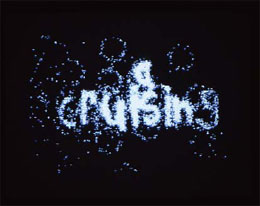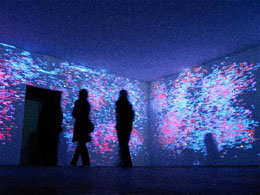2 February – 2 April 2006
Received text
Installations
Show opening Wednesday 1st February starting at 6 p.m.
Tuesday - Sunday, noon to 6 p.m.
Charles Sandison is fascinated by all kinds of theories, be they biological, physical, medical, political, linguistic or other. His attention is particularly drawn to the communication systems they establish and the powers they put in place. Seizing on these theories, he writes a computer program that simulates their application and offers us an in-depth reflection on the territorialization of knowledge and power.

Sandison's works look like this:
Generated by a computer program, words or signs are projected in a darkened location. These move about individually or in groups, chase one another, organize themselves into patterns, wage war among themselves, absorb, stimulate and reject each other, are transformed, and cluster, forever redrawing the borders of a territory where the connections are constantly renewed. The works are installed on site and both adapt to the venue's architecture and sculpt its space at the same time as the traces of light hug any surface they encounter.
Viewers are invited to immerse themselves in the darkness and wander among the words and signs, serving for the occasion as a surface for the projection. Over and over they recompose phrases by filling in the blanks with verbs, or dream up improbable connections, or even let themselves be swept away by the pleasing ballet of light beams and captivated by the strategic movements of these signs. Submerged though not absorbed, they perform different linguistic operations, from the metaphorical to the concrete, and by turns experience these words as objects, traces of light, or even signifiers; they observe the advancement, and hence the influence or dominance, of some words at the expense of others, or interpret them according to their own personal codes.
Despite a simplicity that seems to polarize or caricature connections, the words (good, evil, love, hate, male, female, etc.) construct infinite networks of meaning, which the mind criticizes but which the imagination seizes upon to make them visible in one's inner world.
Rage, Love and Despair (2004) is a good illustration of the above in a number of ways. In that piece, Sandison examines the medieval theory of humors, according to which the human body is governed by four "humors" that are related to four kinds of temperament depending on whether one or the other dominates (choleric, sanguine, phlegmatic, and melancholic). An imbalance between these humors leads in turn to an imbalance in the physical condition. Furthermore, these humors were associated with other properties, such as hot and cold, the seasons, or the different ages of human life, the aim being to sketch out through these associations the universal laws that governed the world and its mysteries. Other propositions that came to be added to the ranks of reductive approaches were devised to understand the workings of human emotions by summing them up with a few basic traits.
In Rage, Love and Despair, Sandison returns to these theories about the emotions and creates by means of a computer program an artificial mind in which he introduces sentiments and moods, each being represented by a word. Each word follows a preprogrammed behavioral pattern. For example, words having something to do with aggression are red and attack the others. Thus, each word is affected by the others. The drawn constellations change color according to the dominant mood (red if aggression predominates) and even the rhythm accelerates according to the emotional function.

A similar principle governs Good and Evil (2002). These two words, one white the other red, are constantly at war with each other. According to how well they fare, the projection takes on the color of the winner. As in Rage, Love and Despair, we are close here to a living organism that is constantly struggling and readjusting itself, while each word seeks to gain ground, programmed to behave like a cancerous cell or a virus. Good and evil simply fight it out, reduced to opposing forces that tinge each other.
Heart of Darkness (2005) casts a complex light on language, making words loom up from the darkness one by one and questioning the source of language. The piece borrows in full the text of the short novel by the same name, the work of the Polish-born English writer Joseph Conrad. Through the fate of two men in the work, Conrad approaches the heart of darkness and sounds the theme of our relationship to evil beyond morality.
The Heart of Darkness projection is made up of little + and – signs of white light, which move about chaotically on a black background before slowly collecting and forming words. The computer program, which is an algorithm organizing the movements of the + and – signs, offers a complete reading of Heart of Darkness in two and half years, even more for the last words to come to light. The textured aspect and the beauty of the darkness are heightened when, from out of the depths, the light forces its way up and seems to pronounce the words.
The Blind Watchmaker (2005) takes us away from words to make us feel a ghostly presence. The piece's title is borrowed from a computer program of the same name developed by the biologist Richard Dawkins in 1986. The program, which simulates the complex mechanisms at work in the principles of the selection and adaptation of biological forms, illustrates Darwin's theory of evolution. The police now make use of the program to reconstruct the faces of missing persons by working with photographs of them. The program analyzes the images and then calculates the probable evolution of the individuals in order to imagine them at a later age, so as not to lose every trace of them.

The computer program behind the projection of The Blind Watchmaker inverts the aging process in order to recover the features of a newborn's face. The effect is startling. The face, like a ghostly presence, seems to come to us from limbo a specter floating there like the moon. The face changes endlessly since the program continues indefinitely to construct and deconstruct what remains of the faces of these missing people by drawing on photo archives. A halo lingers on the retina, haunting our memory and the space.
These visual and textual constructions cannot help but call to mind painting—large schools of signs, like fish, glide over the surfaces, tracing out movements and colors (Good and Evil, 2003). They also recall concrete poetry and of course Stéphane Mallarmé's throw of the dice. Sandison's latest works have begun to reflect on the origin of words and their evocative power; the phenomenon of reminiscence is examined. Highly conceptual in their development, these pieces, displaying a strong element of fascination and charm, summon viewers to an immediate experimentation with no prerequisite necessary inasmuch as their presence makes itself felt beyond words.
Technology and the precision of the program are ultimately in the service of a poetic enterprise:
"Sometimes I try to visualize the journey of a word as it leaves the lips of a speaker and moves towards a listener, or imagine, when standing in a public library, that all the books are quietly talking. the vision that occurs in my mind is that of a vast flock of birds, which seem to move chaotically yet somehow, manage not to collide.
Physical space and the void between the words stand in for pronouns and verbs. I use this articulation between meaning, words, and in between spaces as a way to escape the authoritarian power of language."
Charles Sandison
Isabelle Aeby Papaloizos
Charles Sandison was born in Scotland in 1970. He lives and works in Finland.
Forthcoming Exhibitions
2007
Museum D'Orsay, Paris, France
Galerie Frank, Paris, France
2006
Museum of Contemporary Art Cleveland, USA
Bonn City Art Museum, Germany
Museum of Contemporary Art Kiasma, Helsinki, Finland
Koldo, San Sebastian Museum of Contemporary Art. Spain
Centre pour l'image contemporaine, Geneva, Switzerland
Galerie Max Estrella, Madrid, Spain
Solo Exhibitions
2005
Galerie Arndt & Partner, Zurich, Switzerland
2YK, Berlin, Germany
Galerie Baronian Francey, Brussels, Belgium
Galerie Yvon Lambert New York, USA
Galerie Jean Bernier, Athens, Greece
Cornerhouse Centre for Visual Art, Manchester, UK
Éigse Carlow , Ireland
2004
Galerie Anhava (project space), Helsinki, Finland
Galerie Ulrich Fiedler, Cologne. Germany
RoomX, Kiasma, Helsinki, Finland
Wäinö Aaltonen Museum, Turku, Finland
Lisson Gallery, (Lisson New Space), Londres, UK
2003
Art Basel, Miami Beach, USA poject with Galerie Frank
Galerie Frank, Paris, France
Centre d'art Contemporain Georges Pompidou, Cajarc, France
Lieu d'art Contemporain, Sigean, France
Marseille art dealer art fair (project with Galerie Frank), France
Sketch, London (show solo), UK
2002
Gallery Baronian-Francey, Bruxelle, Belgium
Artcurial, Hôtel Marcel Dassault, Champs-Elysées, Paris, France
Foire Internationale d'Art Contemporain 2002, Paris, France
Galleria Frank, Paris, France
La Criée centre d'art contemporain, France
Galleria Kari Kenetti, Helsinki, Finland
Group exhibitions
2005
'Valohoitoa', Wäinö Aaltonen Museum. Turku, Finland
l'art de produire l'art, Le Fresnoy National Studio for Art, Lille, France
Centro Atlántico de Arte Moderno - CAAM
'Documentary Creations', Kunstmuseum Luzern, Switzerland
Arco, Madrid, Spain
Art Basel, (with Lisson Gallery, Arndt & Partner), Switzerland
Kunsthalle Lophem, Loppem-Zedelgem, Belgium
Corpus Bruges, site specific project, Belgium
2004
'Loop04', Barcelona, Spain
'Art Basel Miami', (with Arndt & Partner, Lisson Gallery) USA
'De leur temps, collections privées françaises', Musée des Beaux-Arts de Tourcoing. France
Galerie Ardnt & Partner, Berlin, Germany
'Algorithmic Revolution', ZKM Centre for Art and media, Karlsruhe, Germany
Foire Internationale d'Art Contemporain 2004, Paris, France
Art Cologne, (avec la Galerie Ulrich Fiedler), Germany
Frieze Art Fair (avec la Galerie Ardnt & Partner) Londres, UK
Villette Numérique, Paris, France
Museum Der Moderne Salzburg, Salzburg, Austria
Panorama 5, Le Fresnoy, Lille, France
Mäntän kuvataideviikot, Mänttä, Finland
Galerie Thaddaeus Ropac, Salzbourg, Austria
Art Basel, (avec la Galerie Ardnt & Partner) Bâle, Switzerland
México Arte Contemporáneo, (avec la Galerie Ardnt & Partner) Mexico
ARCO en el Forum Barcelona 2004, Spain
Moderna Museet, Stockholm, Sweden
The Armory Show, (avec la Gallerie Ardnt & Partner) New York, USA
2003
Collection Yves Lambert, Avignon, France
Artissima, 6-9, Turin, Italy
Art Forum Berlin, Germany
Foire Internationale d'Art Contemporain 2003, Paris, France
